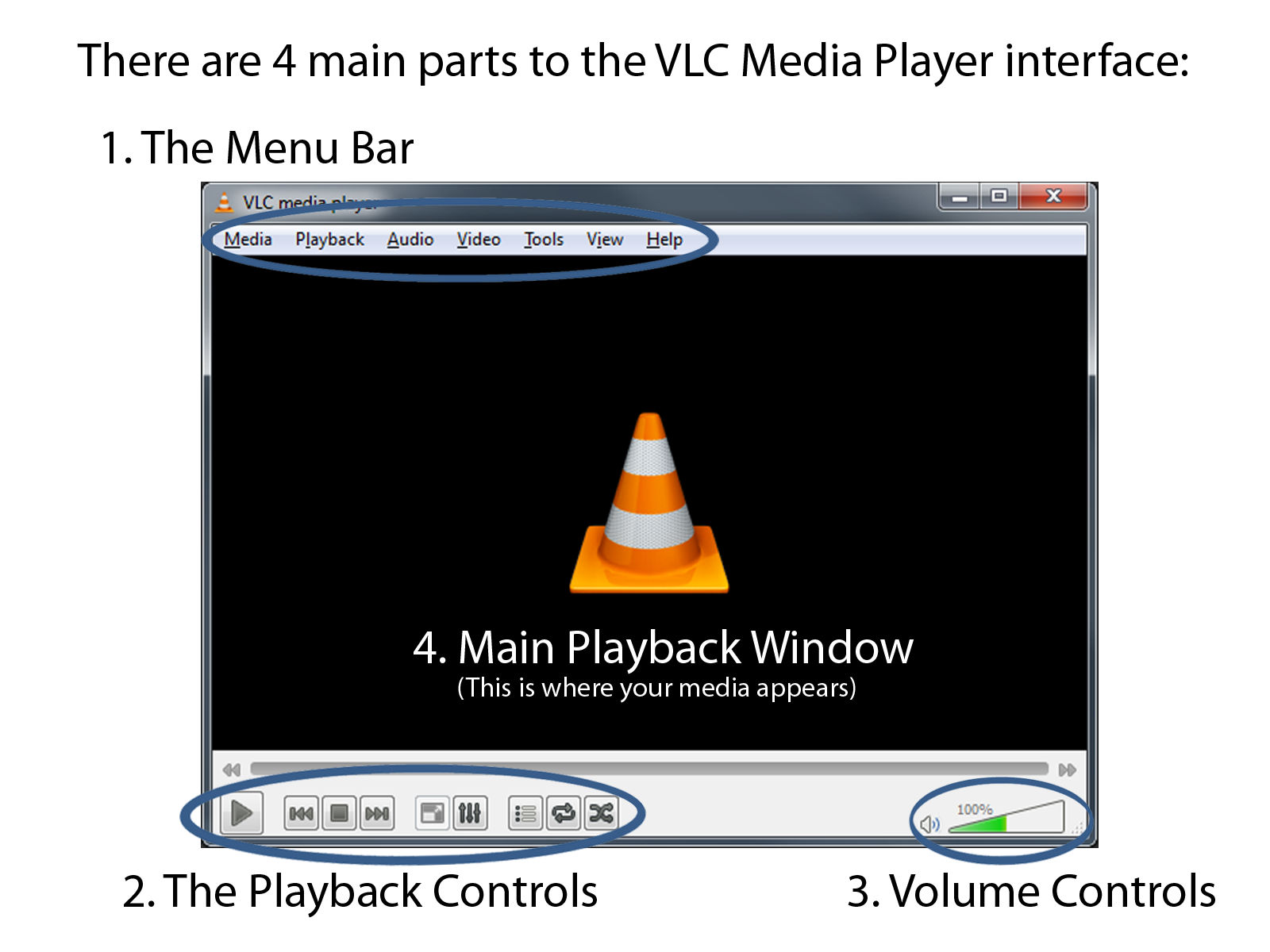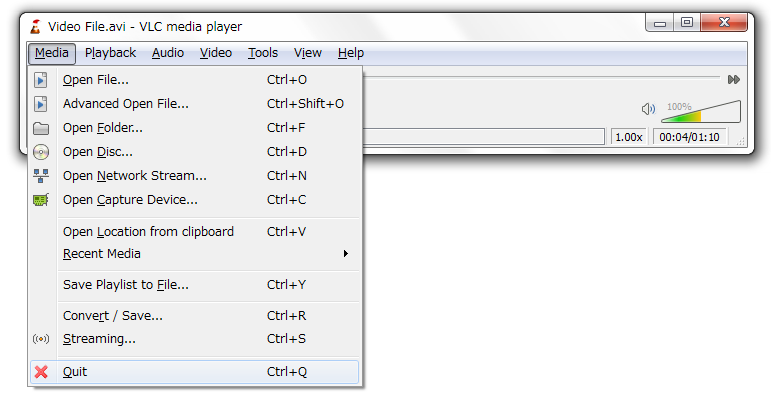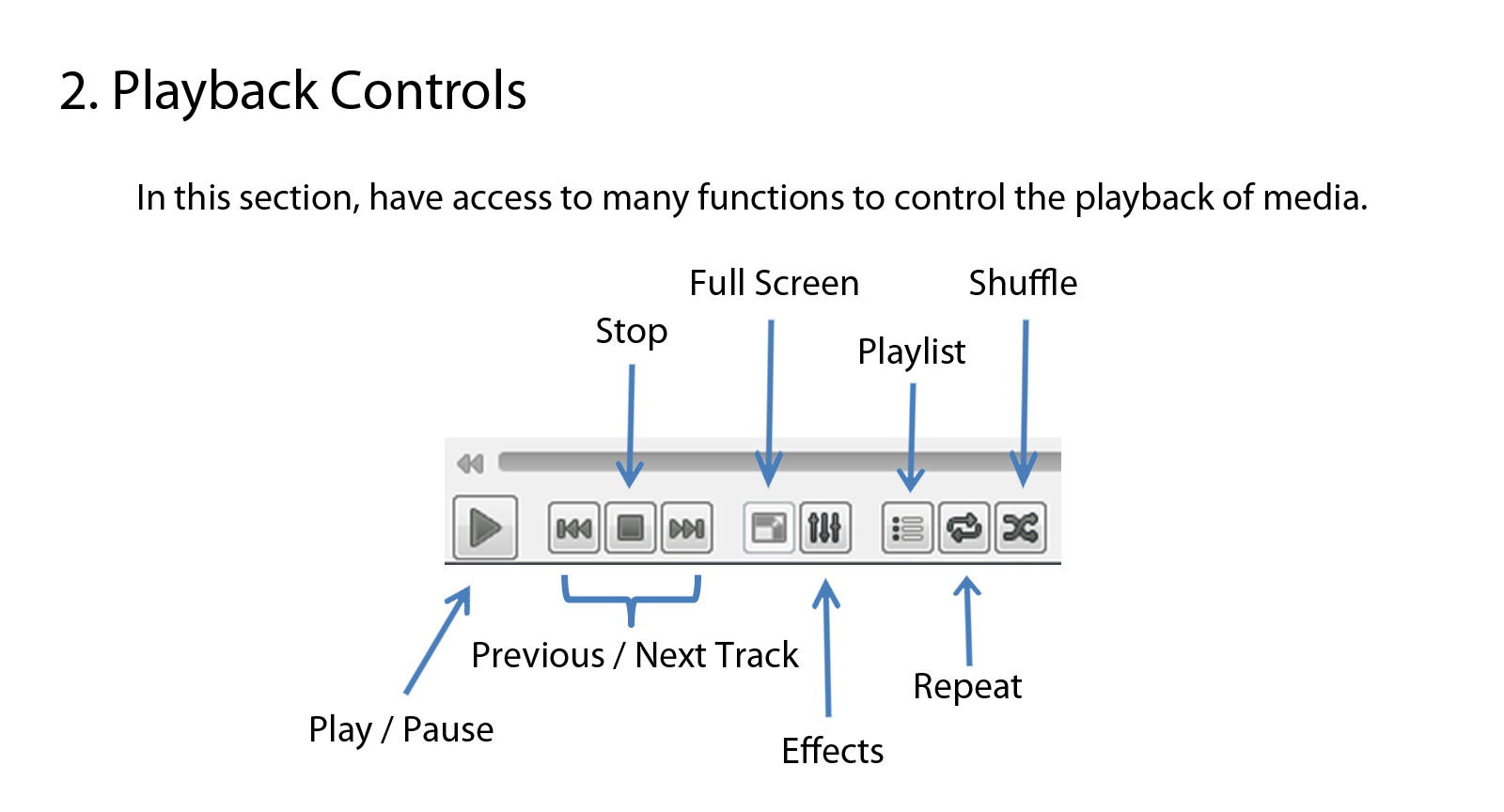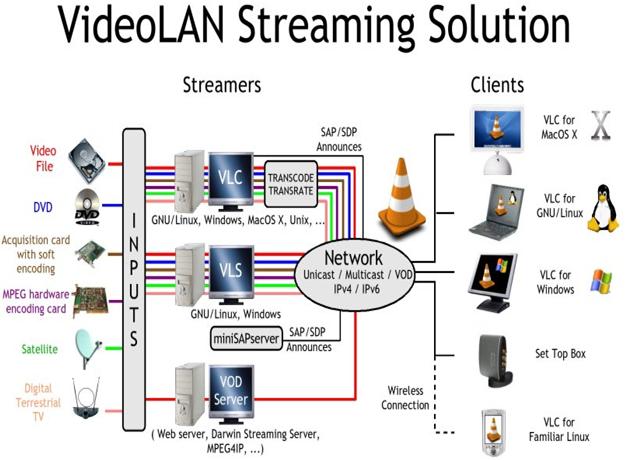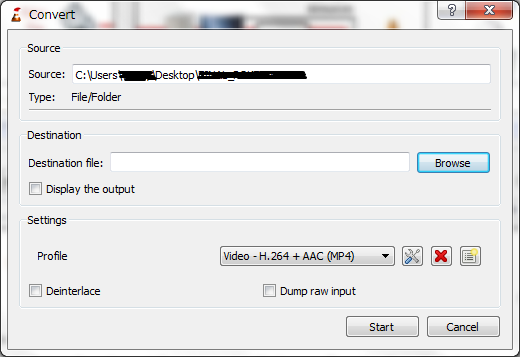Documentation:Interface
VLC has several interfaces:
Contents
General Interface Description
VLC has several interfaces:
- A cross-platform interface for Windows and GNU/Linux, which is called wxWidgets
- A native Mac OS X interface
- An interface which supports skins for both Windows and GNU/Linux.
Below are screenshots of VLC on various interfaces. Despite these different interfaces, VLC's functions essentially work the same on all operating systems.
Windows and GNU/Linux (wxWidgets)
The interface shown below is the default in VLC 1.2 for Windows and GNU/Linux (although this screenshot is from Windows, it will look similar on GNU/Linux). More features can be displayed, by selecting them in the View menu.
Mac OS X
The interface shown below is the default for Mac OS X.
Starting VLC Media Player
To start VLC Media Player:
- Select Programs from the Start menu.
- Select VideoLAN and select the VLC media player.
Or:
- Type in your console vlc
When you start VLC media player, the application appears on the screen and a small icon ![]() appears in the taskbar. Click on the icon in the taskbar to show or hide the icon in the taskbar. Hiding the icon does not amount to quitting the application. It does run in the background even when you hide the interface.
appears in the taskbar. Click on the icon in the taskbar to show or hide the icon in the taskbar. Hiding the icon does not amount to quitting the application. It does run in the background even when you hide the interface.
Stopping VLC Media Player
To quit the application, right click on the ![]() icon in the tray and select Close (Alt-F4).
icon in the tray and select Close (Alt-F4).
Or
Click the Close button in the main interface of the application.
Taskbar Icon
When VLC media player is running, its icon ![]() appears in the taskbar. Click on the icon in the taskbar to show or hide the icon in the taskbar. Hiding the icon does not amount to quitting the application. It does run in the background even when you hide the icon. Basic operations such as opening, playing or stopping a media file, or changing a track can be done from the menu obtained by right clicking the taskbar icon. The main interface contains a couple of sections:
appears in the taskbar. Click on the icon in the taskbar to show or hide the icon in the taskbar. Hiding the icon does not amount to quitting the application. It does run in the background even when you hide the icon. Basic operations such as opening, playing or stopping a media file, or changing a track can be done from the menu obtained by right clicking the taskbar icon. The main interface contains a couple of sections:
Main Interface
Menu bar
The buttons below the track slider contain all the basic playback features.
Track slider
The track slider is below the menu bar. It shows the progress of playing the media file. You can drag the track slider left to rewind or right to forward the track being played. When a video file is played, the video appears between the menu bar and track slider.
Note: When a media file is streamed, the track slider does not move because VLC cannot know the total duration.
Control Buttons
The buttons below the slider help in controlling the media currently playing.
Additional Information
At the bottom of the interface we can find information regarding name of the media file being played, the relative speed at which it is being played, and the elapsed and total duration of the file are displayed. There is an option to increase or decrease the speed of the track.
Right click on the ![]() icon to change the playing speed of the track.
icon to change the playing speed of the track.
| Menu | Option | Description | Hotkey |
| Media | Open File | Select this option to open a media file and play it. | Ctrl+O |
| Advanced Open File | Select this option to open files through a folder, disc, network or a capture device. | Ctrl+Shift+O | |
| Open Folder | Select this option to open a folder with multiple media files and play them in order. | Ctrl+F | |
| Open Disc | Select this option to open discs with different video format. | Ctrl+D | |
| Open Network Stream | Select this option to receive media files from Internet and play them. | Ctrl+N | |
| Open Capture Device | Select this option to receive media files from capture devices such as camcorder, webcam and so on. | Ctrl+C | |
| Open Location from clipboard | Select this option to enter the URL or path to the media you want to play. | Ctrl+V | |
| Recent Media | Scroll over this option to view recently played media. | - | |
| Save Playlist to File | Select this option to save the playlist to a file. | Ctrl+Y | |
| Convert/Save | Select this option to convert media files to different media file formats. | Ctrl+R | |
| Streaming | Select this option to send media files through network and play them live. | Ctrl+S | |
| Quit | Select this option to quit the application. | Ctrl+Q | |
| Playback | Bookmarks | Select this option to bookmark the media file. | - |
| Title | Select this option to randomly access a particular movie in a DVD. | - | |
| Chapter | Select this option to randomly access a particular chapter in a movie. | - | |
| Navigation | Select this option to navigate to different titles and their corresponding chapters. | - | |
| Program | To be added | - | |
| Jump to Specific Time | Select this option to move the track slider to a specific frame of the video or audio file. The media file starts playing from that instance. | Ctrl+T | |
| Audio | Audio Track | Select this option to disable or enable an audio track. | - |
| Audio Channel | Select this option to select a audio channel. | - | |
| Audio Device | Select this option to convert the stereo audio files to mono and vice-versa. | - | |
| Visualization | Select this option to display splashes of colour and geometric shapes while listening to an audio file. | - | |
| Video | Video Track | Select this option to disable or enable a video track. | - |
| Subtitles Track | Select this option to load subtitle files for video files requiring subtitles. | - | |
| Full Screen | Select this option to view the media file in the entire screen. | - | |
| Always On Top | Select this option to display the application always on top when other applications or files are open. | - | |
| DirectX wall paper | Select this option to make the video which is being displayed to become the wall paper. | - | |
| Snapshot | Select this option to capture snapshots of video being displayed. | - | |
| Zoom | Select this option to zoom in or zoom out a video track. | - | |
| Scale | Select this option to resize the video to an appropriate size. | - | |
| Aspect Ratio | Select this option to adjust the width to height ratio of the video. | - | |
| Crop | Select this option to crop the edges of a video track. | - | |
| Deinterlace | Select this option to convert interlaced video signals into non-interlaced form. | - | |
| Deinterlace mode | Select this option to choose the type of deinterlacing. | - | |
| Post processing | Select this option to disable post processing or the processing number. | - | |
| Tools | Effects and Filters | Select this option to adjust the audio and video effects. | Ctrl+E |
| Track Synchronization | Select this option to display a menu of options to have audio and video effects, and synchronization of the audio and video media. | - | |
| Media Information | Select this option to view information regarding the media file being played. | Ctrl+I | |
| Codec Information | Select this option to view codec information of the media file being played. | Ctrl+J | |
| Bookmarks | Select this option to bookmark the media file. | Ctrl+B | |
| VLM Configuration | To be added | Ctrl+W | |
| Program Guide | Select this option to view the program schedule | - | |
| Messages | Select this option to view the messages and the modules tree. | Ctrl+M | |
| Plugins and extension | Select this option to view plugins and extension installed on VLC. | Ctrl+M | |
| Preferences | Select this option to give preferred settings to audio, video, subtitles, codecs and hotkeys. | Ctrl+P | |
| View | Playlist | Select this option to view the playlist. | Ctrl+L |
| Add Interface | Select this option to change the interface. | - | |
| Minimal View | Select this option to enable minimal view (removes track list and basic control buttons). | Ctrl+H | |
| Fullscreen Interface | Select this option to toggle fullscreen mode. | F11 | |
| Advanced Controls | Select this option to toggle advance controls below the tracklist. | - | |
| Docked Playlist | To be added | Ctrl+W | |
| Customize Interface | Select this option to adjust the interface. | - |
Opening modes
See Documentation:Play HowTo/Basic Use 0.9/Opening modes
Streaming Media Files
Streaming is a method of delivering audio or video content across the network without downloading a file before it is played. You can view or listen to the content as it arrives. The advantage is that you need not download large files to watch a movie or listen to music. VideoLAN is designed to stream MPEG videos on high bandwidth networks.
VLC can be used as a server to stream MPEG-1, MPEG-2 and MPEG-4 files, DVDs and live videos on the network in unicast or multicast.
Unicast refers to a process where media files are sent to a single system through the network. Multicast refers to a process where media files are sent to multiple systems through the network.
VLC is also used as a client to receive, decode and display MPEG streams. MPEG-1, MPEG-2 and MPEG-4 streams received from the network or video from a camcorder can be sent to one machine or a group of machines.
To stream a file:
- Select Open Network Stream from the Media menu. Then the Open Media dialog box is displayed. The Network tab is selected by default.
- Type the network URL in the user input box
- Click on the Play button to begin playback of the stream.
Note: When the streaming is being done, the slider moves to show the progress.
For more information, refer to the VLC usage page
Converting and Saving a Media File Format
VLC media player is the best option for multimedia conversion. It can convert different media formats to the format of your preference. To convert a media file
- Select Open File from the Media menu. The Open dialog box is displayed.
- Select a media file and click on the Open button and then the media file will be played.
- Select Convert/Save from the 'Media' menu and the Convert box is displayed.
- Choose the Destination File and the Profile and click Start.
